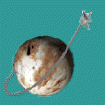
Current Issues:
SpaceViews
SpaceViews Update
Breaking News
Back Issues
Search
Subscriptions
Submissions
Forum
Space Sites of the Week
Home
Mars Pathfinder
Comet Hale-Bopp
Top Ten Stories of '96
Life on Mars?
Pathfinder Results Provide New Insights on Martian Surface, Interior
Despite the recent communications problems with the Mars Pathfinder lander, data returned previously by the spacecraft has provided scientists with new information about the surface and interior of the planet.
![[image of wind streaks on Martian surface]](../971015/images2/marsstreaks.jpg) Images from the Pathfinder lander, also known as the Sagan Memorial Station, and the Sojourner rover have provided additional evidence that liquid water once flowed on the Martian surface. The images, which show evidence of sand, instead of pebbles or dust, also point to the wind as a force that helped shape the Martian surface through erosion.
Images from the Pathfinder lander, also known as the Sagan Memorial Station, and the Sojourner rover have provided additional evidence that liquid water once flowed on the Martian surface. The images, which show evidence of sand, instead of pebbles or dust, also point to the wind as a force that helped shape the Martian surface through erosion.
"We've made significant progress in establishing that water was a dominant agent in forming the surface, and now we can say that there is another agent at work, and that is the wind," said Dr. Wes Ward of the U.S. Geological Survey's Flagstaff office.
The discovery of sand, intermediate in size between pebbles and dust, likely requires the existence of water to create it, geologists said. The sand seen in the Pathfinder images has been shaped into small dunes by the wind.
"What the data are telling us is that the planet appears to have water-worn rock conglomerates, sand, and surface features that were created by liquid water," said project scientist Dr. Matthew Golombek. He added that if later data showed rocks to be made of composite materials -- rocks of different types brought together by sedimentation -- it would mean liquid water once flowed there, a "very important finding."
Scientists measuring the Doppler shift of the radio signals from Pathfinder has also found evidence of a separate core for Mars. "By measuring the spin axis of Mars, we can learn something about the interior of the planet, because the speed of the change of its orientation is related to how the mass is distributed inside," explained Dr. William Folkner.
Data from Pathfinder show that Mars may have a solid iron core at least 1,300 km (800 mi.) in radius, or a combination iron-and-sulfur core about 2,000 km (1,200 mi.) in radius. The radius of Mars itself is 3,400 km (2,100 mi.).
The existence of a core implies the planet was geologically active for some time early in its history, which could have in turn helped create conditions on the surface more hospitable for life by recycling carbon dioxide and other gases.
